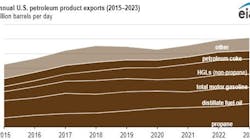Nick Snow
OGJ Washington Editor
WASHINGTON, DC, Mar. 9 -- Continuing unrest in Libya and other North African and Middle Eastern countries has raised world crude oil prices to their highest level since 2008, the US Energy Information Administration said in its latest short-term energy outlook on Mar. 8. It raised its forecast for the average 2011 cost of crude for refiners by $14/bbl from its previous outlook to $105/bbl as a result.
The federal energy forecasting and analytical service increased its 2011 average price for West Texas Intermediate crude by only $9 month-to-month to $102/bbl because of the continued price discount for the US benchmark relative to other crudes. It projected a further increase in crude prices for 2012, with the refiner acquisition cost averaging $106/bbl and WTI averaging $105/bbl.
EIA said it expects global crude markets to tighten further in the next 2 years, particularly because of recent political unrest in North Africa and the Middle East, the world’s largest producing region.
“The current situation in Libya increases oil market uncertainty because, according to various reports, much of the country's 1.8-million b/d total liquids production has been shut in and it is unclear how long this situation will continue. The market remains concerned that the unrest in the region could continue to spread,” EIA said.
EIA indicated that other factors likely to push crude prices even higher include decisions by key members of the Organization of Petroleum Exporting Countries about their production response to recovering global oil demand and recent supply losses; the rate of domestic and global economic recovery; fiscal issues facing national and subnational governments, and China’s efforts to address concerns about its growth and inflation rates.
US production
EIA also forecast that US crude production, which grew by 150,000 b/d to 5.51 million b/d in 2010, would decline by 110,000 b/d in 2011 and by 130,000 b/d in 2012. It said the 2011 forecast includes declines in Alaska of 60,000 b/d in 2011 and a further 10,000 b/d in 2012 because of maturing fields there. EIA also forecast that production from the US Gulf of Mexico would drop by 240,000 b/d in 2011 and another 200,000 b/d in 2012.
The Alaska and gulf production declines will be offset by projected increases in the Lower 48 states of 190,000 b/d in 2011 and 70,000 b/d in 2012, it added.
EIA said net liquid petroleum fuel imports, including crude and products, fell from 57% of total US consumption in 2008 to 47% in 2010, primarily because of falling consumption during the economic recession and growing US production. It expects combined product imports to average 9.7 million b/d in 2011 and 10 million b/d in 2012, comprising 50% and 52% of total US petroleum consumption, respectively.
Total marketed natural gas production increased by 4.4% during 2010 from an average 59.7 bcfd in January to an estimated 63.8 bcfd in December, according to EIA. It forecast year-to-year growth during 2011 of only 0.8% as a 1 bcfd increase in the Lower 48 is partially offset by a 500 MMcfd decrease in the gulf.
Although EIA’s latest data in its Natural Gas Monthly show continuing production growth in the Lower 48 during December, the forecasting and analytical service said that it expects modest declines through 2011 as fewer wells are drilled in response to lower gas prices.
It said that Baker Hughes Inc. reported that the number of rigs in the US drilling for gas increased from a low of 665 in July 2009 to 973 in April 2010. The gas rig count stayed relatively stable from April to October before it began to fall, hitting 906 as of Feb. 25, 2011.
“The large price difference between petroleum liquids and natural gas on an energy-equivalent basis contributes to an expect shift toward drilling for liquids rather than for dry gas,” EIA said in its latest STEO.
Contact Nick Snow at [email protected].

